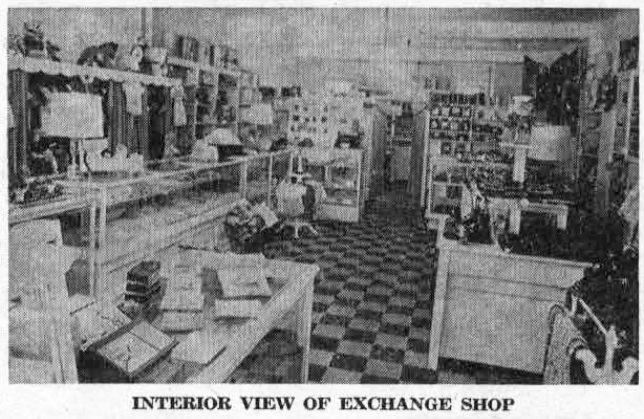 Looking down the vista of the years ahead, not one among that small group of ambitious women who started the Woman’s Exchange in Wayne in 1931 could have visualized the beautiful shop and tea room at 185 East Lancaster avenue as it looks today.
Looking down the vista of the years ahead, not one among that small group of ambitious women who started the Woman’s Exchange in Wayne in 1931 could have visualized the beautiful shop and tea room at 185 East Lancaster avenue as it looks today.
At that time, only some 50 consignors brought their handicraft to the small and unpretentious shop on Audubon avenue, since renamed South Wayne avenue. Now there are more than 300 consignors, who bring what they make to an Exchange that by 1940 had reached fifth place in gross sales among the 35 member organizations of the Federation of Woman’s Exchanges in the entire United States.
In May, 1950, this Federation held its annual meeting in Wayne, with the local group serving as host, and with delegates from as far away as Cincinnati, Pittsburgh, Richmond, New Haven, New York, Scarsdale and Stamford.
Almost phenomenal as the growth of the Wayne Woman’s Exchange seems, it was closely connected with national economic conditions in the early 1930’s. In the period of a national depression, heads of families were losing jobs, family savings were rapidly used up, with some disappearing overnight with the closing of banks. What the women in these families could earn, even in a small way, was all that kept many from actual need.
The Wayne Exchange, like many similar organizations throughout the country, helped these women to help themselves by providing an outlet for their products. Some sewed, others knitted, while still others baked. There were ways to earn a bit of money that some had never dreamed of until necessity called forth talents to which their owners had given little heed previously. Off to an auspicious beginning in the 1930’s the success of the Exchange continued on into the more prosperous years that followed. Then came the war with its various shortages, among them that of sugar. While the ordinary housewife could obtain perhaps barely enough of that commodity to meet her family’s everyday needs, the Exchange was able to obtain it in larger quantities for the use of its consignors. And while the supply of cakes and cookies never met the demand for them, nevertheless the situation was somewhat relieved.
The charming interior of the Exchange is shown in the picture illustrating this week’s column. On every side are showcases, full to overflowing with the handiwork of more than 300 consignors. Hand knitted afghans, bootees, sweaters and caps for the youngest member of the family, smocked dresses and pinafores, and for little brothers, suits, hand knitted sweaters and socks – all are of unusual design and painstakingly made. For older sisters and their mothers there is a charming line of handmade sweaters, as well as skirts and blouses.
Clothes form but one part of an extensive stock of articles. To name but a few of the hundreds of these, there are lamp shades, hooked rugs, knitting bags, crocheted mats, aprons of all descriptions, children’s toys, handmade jewelry, pincushions, lingerie cases, etc. Hand monogramming is done on order, dolls are dressed, baby bassinettes are trimmed, rugs mended, and men’s shirt collars turned.
As to food, the long list includes casseroles, sandwiches, cutlets of all kinds, chicken pies, roast turkey, baked ham, etc. There are cakes of all kinds, including special birthday ones, and cookies, too. Many of these items are served in the charming small tea room on the second floor, as well as being sold over the counter.
The Exchange is a non-profit organization, run entirely for the benefit of women who need to add to their incomes, many of them in the older age group. For some of them this additional income means the chance to contribute to their church work or to favorite charities. It means, too, family gifts that could perhaps otherwise not be afforded. And best of all, there is the opportunity to make use of their talents.
Mrs. Edward H. York, Jr., is the present chairman of the exchange, with Mrs. Robert A. Apple as her vice-chairman. Mrs. DeWitt C. Clement serves as executive secretary and manager, with Mrs. Arthur C. Sherman to assist her. Mrs. William T. Grugan is secretary and Miss Marguerite Johnson, assistant secretary. Miss Elizabeth Adams manages the Tea Room, with Mrs. Ann Friel as her assistant. Since the budget does not permit a large paid staff, there is need for many volunteers. Among those who give generously of their time are a number of Junior League members, earning their credits for the League by working in three-hour shifts in the various departments of an enterprise that, for the last 20 years, has meant much to many people.
